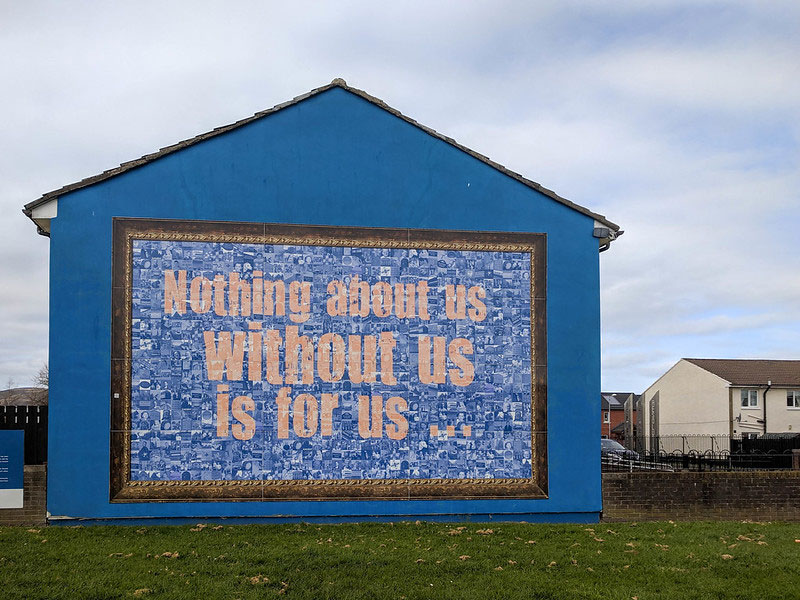Youth in Decision-making: a Study on the Impacts on Adults and Organizations, provides research and analysis that is critical to our ability to properly frame this complex topic. The Center has kindly provided a historical context and a summary of the findings adapted from the report by Shep Zeldin and his colleagues at the University of Wisconsin, Madison. The full report is available online at (www.theinnovationcenter.org), or contact the Center at 301-270-1700 or [email protected].
For almost one hundred years, young people have been progressively isolated from community and organizational decision-making. It is not only young people who suffer from this phenomenon; communities and our larger social systems also suffer. A community–a nation–cannot achieve optimal health while discouraging a major segment of its membership. And when that segment is our future leadership, the need for us to consciously involve youth in everything we do becomes an imperative.
Youth infusion is a term that refers to the fundamental goal of integrating youth and young adults into all spheres of community life, ensuring that their voices and actions are valued and used in efforts aimed at social or community change. An institution is “infused” when youth are valued as effective partners and when structures are created at multiple levels to ensure that the voices of young people are represented in decision-making.
“Youth participation” occurs when adults involve youth in responsible, challenging action that meets genuine needs with the opportunity for planning or decision-making that affects others, youth and adults mutually teach and learn from each other, and each age group sees itself as a resource for the other and offers what it can uniquely provide.[1]
As with any field of practice, the terminology that distinguishes one theory of practice from another, especially during a period of transformation, is difficult to interpret from the outside. It helps to have a comprehensive understanding of policy history, practitioner history, and sector history to get a clear picture.
In Colonial America, young people were not isolated from adults-they worked, either with their families or as apprentices to others. Formal schooling was rare and the education and socialization of young people was the responsibility of the adults with whom they worked. But during the second half of the nineteenth century, industrialization changed the social position of youth. First, industrialization replaced the labor economy that relied on the contributions of children and apprentices. Second, it led to urbanization. High-density living, which created more visible “immoral” behaviors such as drinking, sexuality and vagrancy, resulted in the societal belief that young people had to be protected from potential dangers.
The country enacted child labor laws, primarily intended to protect young people from the abuses of industrialists, and developed public school systems. Gathering nearly all of the young people together for the first time created a new type of intergenerational isolation that had not existed before.
Although these reforms were badly needed at the time to protect vulnerable young people, over time, the resulting separation has led to children being viewed increasingly as “different and something to fear.”
In 1904, G. Stanley Hall published a book entitled, Adolescence: Its Psychology and Its Relations to Physiology, Anthropology, Sociology, Sex, Crime, Religion and Education. Its title alone gives an idea of the importance and danger popularly associated with this stage of life. Social institutions were created to meet the needs of this newly isolated generation of young people including juvenile courts, reform schools, and clubs. These programs often emphasized group activities and civic education with military overtones. By 1930, clubs and gangs of youth were considered social organizations. The goal of youth workers was to turn these gang instincts toward socially productive functions through the development of such organizations as Boy Scouts.[2] Sociologist August Hollingshead interpreted these programs as “efforts to segregate adolescents from the real world that adults know and function in.”
The focus on the pathology and danger of adolescents has had a long shelf-life. Throughout the 1900s, many policy-makers and advocates continued to view adolescence as a time for youth to develop, experiment with adult roles, and begin to make life decisions, but the prevailing view was to search for solutions to youth in upheaval. This fear and youth-adult isolation has continued and is now embedded in our western economic system. “The short answer to why Americans harbor so many misbegotten fears,” writes Barry Glassner, “is that immense power and money await those who tap into our moral insecurities.”
Ethnographic research across 186 societies leads to the conclusion that youth in the United States, more than other countries, operate on the fringes of adult life.[3] Our young people remain especially isolated with regard to responsibilities in community decision-making and action. But prolonging their dependency and segregating young people from the adult decision-making world contributes to and sustains stereotypes, resentment and suspicion. This is bad for communities in too many ways to count, but for now we will focus on the damage it causes to the third sector’s ability to involve itself powerfully in developing moral leadership and its capacity to develop a broad base of leadership for involvement in community and societal governance.
“Storm and stress” is the dominant cultural metaphor for adolescence. Researcher Bradford Brown observed that adults have a false image of a monolithic youth culture, one that portrays young people as being alienated from adult value systems. Adults view adolescence as a turbulent period of life, characterized by conflict with parents, rebellion, mood disruptions and frequent risk-taking behavior. In one study, college students and parents generated a range of descriptors of adolescents–78 percent of the categories were negative. When asked to identify a phrase that best characterizes young people, almost three quarters of the general public describe teens in negative terms. When asked if today’s children will make America a better place in the future, only 38 percent agree.
More generally, a body of knowledge is emerging to indicate that cultural stereotypes negatively affect adolescents on a daily basis. To illustrate, parents consistently underestimate the ability of their children to reach certain developmental milestones as early as the literature suggests that they might. Negative adult stereotypes and low expectations for young people have been found to have broad influences. Stereotypes negatively impact parenting practices, teaching practices, the diagnoses and interventions of mental health professionals, and the diminishing relationships and effectiveness of youth workers, educators, and mentors.
If, in general, adults do not view youth as effective decision-makers, it is not surprising that nonprofit organizations do not typically create such roles and responsibilities for young people. In fact, the ironic but very sad reality is that even many youth serving organizations have been lax and unskilled at involving youth in the development or governance of those programs. Those organizations that have more recently begun to significantly involve youth, however, are seeing truly transformational results.
Despite the challenge of youth-adult isolation, many organizations have made efforts to engage youth. Campfire USA, for instance, has long been an advocate for youth participation in its organization, even going as far as working to change laws about youth participation on nonprofit boards in New York. But the vast majority of social service organizations continue to see youths as clients to be served, rather than as a resource for organizational effectiveness.
The emphasis of this transformation, occurring across the field of youth development, is on involving youth in decision-making and otherwise acting side-by-side with adults in community life. Therefore, by its very definition the transformation cannot remain confined to this field. As we build our infrastructure through which a new conceptual framework is defined and tested and shared, we must be active about infusing the concept into the rest of the sector and beyond.
Much like the positive development of a person, the development of a field takes will, intentionality, curiosity and an enormous amount of rigor and communication. Youth workers strive as a field to reach mastery, defined here as involving, first, continuous clarification of what is important and, second, continuous learning to see current reality more clearly. Mastery is a process that both maps the past and plans for the future. Not a definitive statement of the truth, mastery is, rather, rigorous inquiry into what is and the conflicts and dilemmas that limit the potential for desired change.[4]
Positive youth development focuses not on pathology but rather on health, development and community. This approach views youth empowerment and exploration, competence and mastery, emotional health, compassion and generosity, community connections and belonging, and civic participation as indicators of positive youth development.
Youth decision-making is a key strategy in youth development because it is a key strategy for any community building process. This broader lens of positive youth development implies and challenges the field to do deeper and more intentional research with the outcomes informing good practice at individual, organizational and systems-wide levels.
Sign up for our free newsletters
Subscribe to NPQ's newsletters to have our top stories delivered directly to your inbox.
By signing up, you agree to our privacy policy and terms of use, and to receive messages from NPQ and our partners.
During adolescence many young people are driven to explore issues of social justice. They are creating and experimenting with their own principles and cause-based ideas. This can lead them to become involved in third sector nonprofit organizations, which means they can potentially have a powerful and positive effect on those organizations and the adults involved in the organizations.
Anecdotal evidence in the field suggested that young people can be effective contributors to organizations, but we lacked the base of empirical research to prove the point. So, in 2000, we commissioned a study with the University of Wisconsin, Madison in partnership with the National 4-H Council, the 4-H Youth in Governance Taskforce, and University of Wisconsin Extension. Rather than looking at the impact on young people, we focused our inquiry on the impact that youth have on adults and organizations when they are engaged in decision-making roles.
Our research indicates that almost all the young people we talked to who were engaged in governance roles had prior experience in organizations. They came from a variety of socio-economic backgrounds, but the commonality was that they had a history of being participants and volunteers in community organizations. It is clear that the organizations chose the most qualified persons based on their skill, commitment and connections. This speaks profoundly to the need for the sector to create options for decision-making at all levels within our organizations to ensure that the greatest number and most diverse set of young people can participate and gain the knowledge and skills to master broader governance roles in the future.
In terms of immediate contributions, young people often speak their minds and bring a fresh perspective to organizational decision-making. In our study we heard adults comment on how young people change the content quality of discourse and procedure on governing boards, commissions and other planning bodies.
Young people bring first-hand knowledge of youth-their interests, concerns, fears, passions. They bring connections to other young people and can leverage the participation and skills of their peers.
Close youth-adult partnerships where work is being decided on and produced provides the opportunity for adults to be doubly productive as they pass along their administrative, programming and infrastructure development skills as well as their connections and political wisdom to young people. And for their part, young people report that they value the advice, instruction and direction they receive when the partnerships are crafted well.
Involving young people in organizational governance represents one of the most innovative strategies for promoting youth and community development. Our data indicate that organizations can achieve an impressive array of positive outcomes when they make youth-adult partnerships an operational priority.
The community building field and youth development field must get beyond the development of a few “poster children” to the development of a broad systemic approach to building the skills needed for youth participation in community life, including decision-making. Attitude change does not occur when adults perceive their work with youth to be symbolic or tokenistic in nature. Instead adult attitudes change when the interactions are goal-oriented and purposeful, are lengthy, and have meaningful consequences.
Because youth are a marginalized population in society, an organization that is interested in youth infusion must be prepared to support and engage the young people with the realistic support and expectations needed to be a part of an organization. These are addressed from a number of perspectives elsewhere in this issue of the Nonprofit Quarterly, but here we address some of the necessary conditions for organizational change as we see them:
* The board of directors is committed to youth governance and entrepreneurial decision-making.
* Adult leaders strongly advocate for including young people in decision-making roles.
* Youth provide pressure and support for increasing youth participation in governance.
* Adults experience a variety of interactions with youth-one meaningful interaction is not enough to change long-held attitudes.
* Organizations provide support for youth through a variety of decision-making opportunities.
* Organizations involve older youth in decision-making early on in the organizational change process.
Organizational effectiveness is a collective concept. It arises from the interplay of contributions made by diverse persons. It requires a deep respect for the contributions of each organizational player and the collective intelligence that emerges when true mastery-defined here as continuous clarification of what is important and continuous learning to see current reality more clearly-is not exclusionary of those who must eventually and carry the work forward.
This research clearly indicates that when leaders infuse young people with organizational decision-making and planning responsibilities, adults note an impressive change in the quality of discourse and governance within their organizations. Unfortunately, most organizations do not see a role for youth in their work, and those that do often create token or window dressing roles. Leaders who continue this practice diminish the effectiveness of their organizations. We hope this research convinces organizations to recognize and engage the resources and visions of young people.
1. National Commission on Resources for Youth. 1974. New Roles for Youth in the School and Community. New York, NY: Citation Press
(pages 25, 227).
2. Chudacoff, H. P. 1989. How Old Are You? Age Consciousness in American Culture. Princeton, NJ: Princeton University Press.
3. Arnett, J. A. 1999. “Adolescent Storm and Stress, Reconsidered.” American Psychologist. (54): 317-326
4. Comino, L. and Zeldin, S. 2000. “The Journey of the Learning Community: Report of the Building Bridges between Practice and Knowledge” in Nonprofit Management Education Initiative. Battle Creek, MI: Kellogg Foundation.
www.AtTheTable.org A new online clearinghouse featuring information about effectively involving youth in your organization and community.
The Innovation Center is a national intermediary whose network of staff and partners seek, test, and provide cutting edge tools for youth workers.













